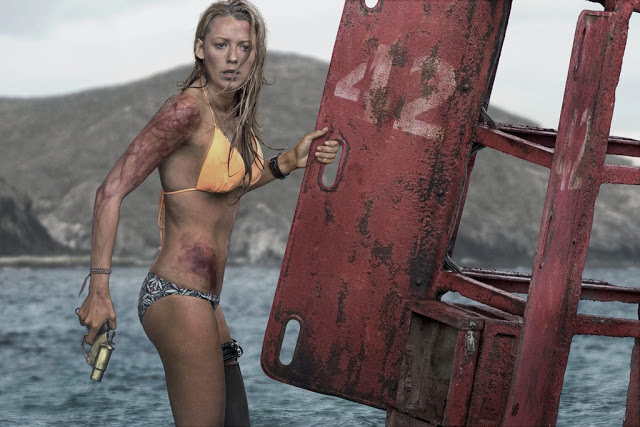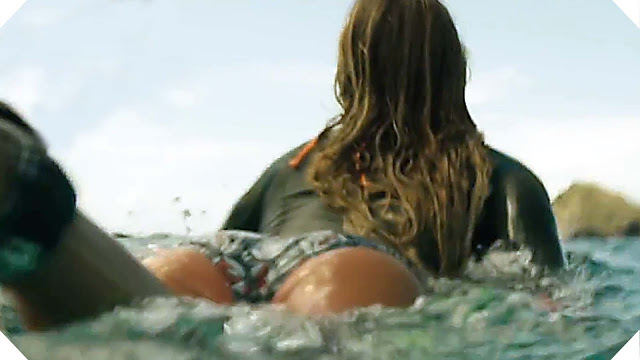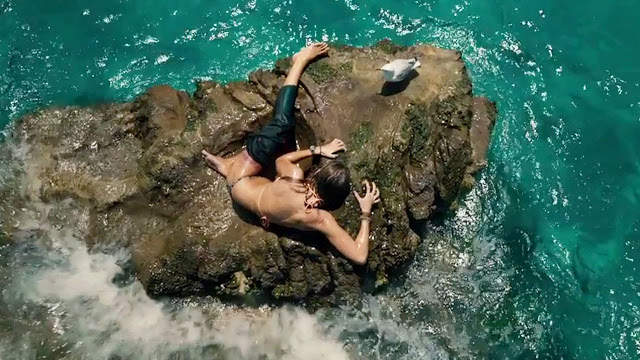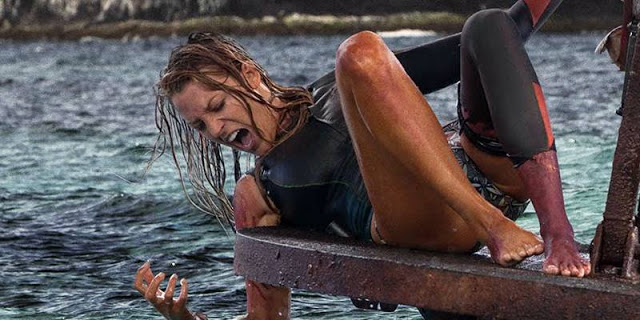Water, water is everywhere in The Shallows, and there isn’t a drop to drink, though that’s due less to its salt than its color. Not long into this lean, mean thriller from Jaume Collet-Serra, the tranquil blue of the sea’s waves gets stained with blood, and a peaceful getaway transforms into a harrowing struggle of survival. It never becomes anything more than that, but that’s part of its charm. The Shallows may lack the towering ambition of Gravity or the scrupulous minimalism of All Is Lost, but its gritty flair and appealing star nevertheless make it a worthy entrant in the “man vs. nature” canon. At the very least, it will have you thinking twice the next time you consider wading into the water.
Not that The Shallows‘ opening act is particularly frightening; in fact, if you ignore the scary tone-setting prologue, it’s positively idyllic. Our protagonist is Nancy (a revelatory Blake Lively), a medical student journeying to a secluded Mexican beach that her mother once told her about. It’s as advertised, with golden sand leading into a majestic gulf whose giant waves render this isolated inlet a surfer’s paradise.
And Nancy is quite the surfer. The film’s first half hour, in which Nancy rides the waves with inveterate ease and visible joy, plays like a flashy YouTube highlight video. Collet-Serra is composing a visual valentine, though it’s difficult to say which he’s smitten with more: the righteous rhythm of the surf, or his leading lady’s form. With sun-kissed hair and legs that stretch out to the horizon, Lively is a walking, talking, swimming fantasy, and Collet-Serra’s camera ravishes her body with an enthusiasm that verges on pornographic. It’s a deliriously sinful approach that can feel distracting, even if honesty compels me to acknowledge its prurient benefits. But Nancy has more important things to worry about than voyeuristic exploitation.
In other words: “SHAAAARK!” As it turns out, this slice of heaven isn’t so isolated after all. During one of her surfing runs, Nancy finds herself thrown from her board, then wails in pain as a great white suddenly chomps on her leg. It’s a thrilling, terrifying sequence, not least because we, like Nancy, never see the shark. (The Shallows is no Jaws, but Collet-Serra clearly attended the Steven Spielberg Academy of Visual Withholding.) The scene crests with a static underwater shot of Nancy thrashing against the waves as the cobalt water slowly curdles into a deep, dark red. The Shallows features its share of impressive images, but this is easily its most memorable, which is saying something, given that the movie features extensive footage of Blake Lively in a bikini.
Beauty is beside the point in The Shallows, even if you can’t help but be astonished by the gobsmacking loveliness of its natural location. (Filming took place off the coast of Australia, with Collet-Serra shooting in digital.) It’s all about survival, which means that—much like Gravity, The Martian, Cast Away, and countless others—it’s a study of problem-solving and perseverance. Following her initial meet-munch-crunch with the shark, Nancy finds herself marooned on a tiny rock outcropping, roughly 200 yards from land, as her fishy foe continuously circles her. From her pitiful haven, she gamely tackles a number of dilemmas: creating a tourniquet to stanch the blood from her wound, staying warm as night falls, attempting to communicate with any passerby who appear on the beach, and—in the film’s most agonizing scene—using her jewelry to suture the gash in her leg. (In a sign of both Nancy’s and the movie’s intelligence, she briefly removes the tourniquet at one point in order to return the blood flow to her foot.) All the while, the tide is growing higher, Nancy is growing weaker, and the shark isn’t looking any less hungry. She’s going to need a bigger rock.
Collet-Serra, best known for his trio of action thrillers with Liam Neeson (Unknown, Non-Stop, and Run All Night), wisely stages Nancy’s tribulations with minimal fuss, relying on Lively and that omnipresent dorsal fin to keep the tension ratcheted high. He’s clever with the frame—in the film’s earlier scenes, he displays Nancy’s electronic communications via textual panels that make good use of space without taking the focus off Lively’s face—and he generally strikes a good balance between showing and telling. To that end, he provides Nancy with a companion in the form of an injured bird, whom Nancy adorably dubs “Steven Seagull” and who serves as a captive audience to her occasional muttering. (Suffice it to say that this isn’t All Is Lost, which famously featured Robert Redford saying just a single four-letter word for its entire runtime.) It’s a gesture that obviously recalls Wilson, the volleyball Tom Hanks befriended in Cast Away, but if Collet-Serra indulges in sporadic hand-holding through Nancy’s dialogue, he never relieves you of the gravity of her predicament.
In this, Collet-Serra relies enormously on his star, and would you believe it, Lively delivers. I’m largely unacquainted with Lively’s work—outside of her brief appearances in The Town and Savages, I know her best from a scene in Girls where Lena Dunham compares her in absentia to a cloud formation—but I can’t imagine that even the most ardent Gossip Girl diehard could have predicted this. Nancy is an immensely challenging role, and Lively brings her to vivid, fragile, deeply human life. The Shallows‘ success hinges on whether we sympathize with Nancy; if we don’t, then it’s just another slasher flick with a shark in place of a serial killer. Lively understands this, but she doesn’t prey on our sympathy so much as invisibly gather it, avoiding histrionics to reveal a more distressing and pervasive panic. Through small gestures and measured line readings, she effectively conveys Nancy’s pride, her smarts, and, most of all, her fear.
It’s such a persuasive performance that it renders some of The Shallows‘ expository flourishes superfluous. For example, Collet-Serra and screenwriter Anthony Jaswinski hardly needed to saddle Nancy with a treacly backstory involving a dead mom, a wounded dad, and a stalled career. When done right (as in Gravity), backstory can deepen our attachment to a character in crisis, but here, it feels hackneyed, distancing us from Nancy rather than bringing us closer to her. And the film’s coda is useless to the point of being insulting, a betrayal of the taut ferocity that it sustains for so long.
So be it. For a movie about a chick and a shark, The Shallows is robust entertainment, a slickly packaged nightmare that’s both chilling and exciting. There may be more thought-provoking pictures released this year, but few are likely to provide an image as iconic as a shark leaping out of the water, bursting into flames, then suddenly disappearing beneath the waves, still lurking as an unseen threat. When you venture out for a swim this Fourth of July, good luck banishing that vision from your head.
Jeremy Beck is the editor-in-chief of MovieManifesto. He watches more movies and television than he probably should.





Luke and I felt like the ending really ruined the movie. It all felt semi-realistic until the shark jumps through the fire and then gets mangled by spikes. Granted Luke would have liked a more depressing end, I just wanted something more realistic. Nice inclusion of the butt shot BTW ;).
-Sarah